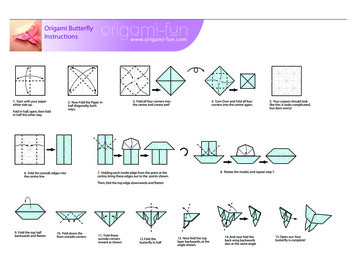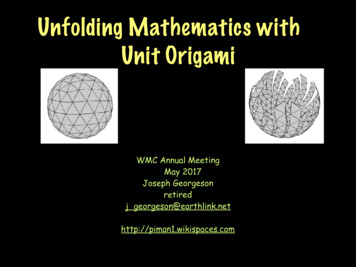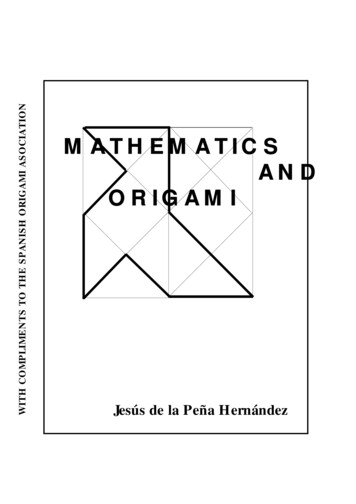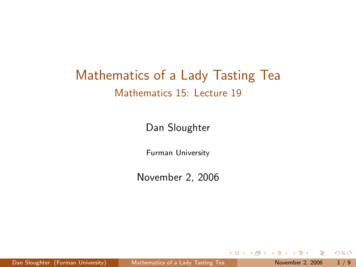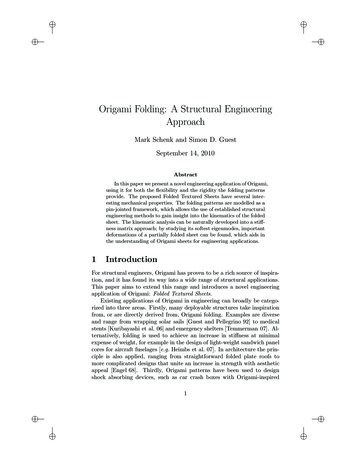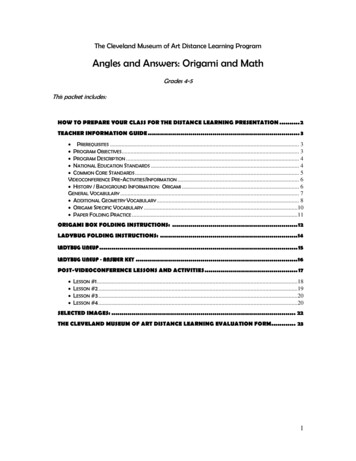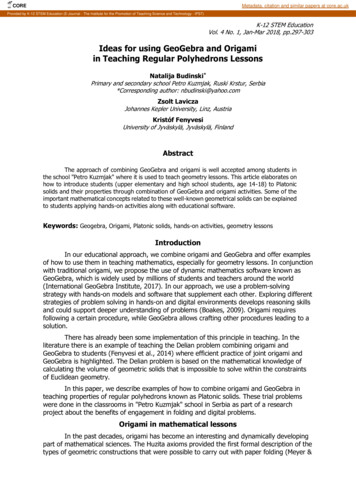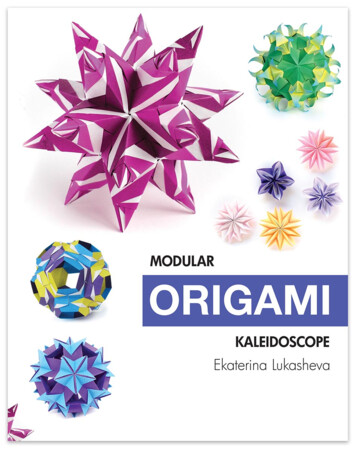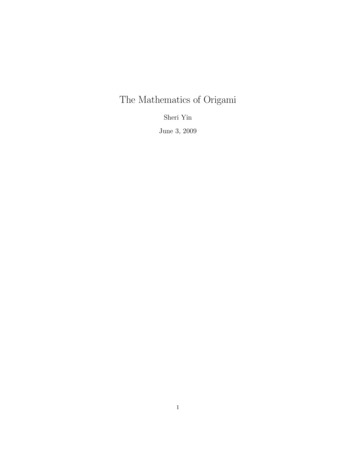
Transcription
The Mathematics of OrigamiSheri YinJune 3, 20091
Contents1 Introduction2 Some Basics in2.1 Groups . . .2.2 Ring . . . .2.3 Field . . . .2.4 Polynomials3Abstract. . . . . . . . . . . . . . . . . . . . .Algebra. . . . . . . . . . . . . . . . . . . . .444553 Properties of Origami3.1 Basic Constructions . . . . . . . . . . . . . . . . . . . . . . . . .3.2 Origami Numbers . . . . . . . . . . . . . . . . . . . . . . . . . . .779.4 Possible Origami Constructions115 The Complete Axioms of Origami136 Conclusion162
1IntroductionOrigami is a type of art first originated from Japan. It is possible to foldmany beautiful shapes in origami. Most amazingly, many astonishing piecesof origami are produced from a single piece of paper, with no cuttings. Justlike constructions using straight edge and compass, constructions through paperfolding is both mathematically interesting and aesthetic, particularly in origami.Some of the different categories of origami are presented below: Modular Origami Origami Tessellation Origami Animal3
There are many other beautiful shapes that can be constructed through paperfolding. Surprisingly, it turns out that origami is much more powerful thanstraight-edge and compass creations, because many things that cannot be created using straight-edge and compass, such as the doubling of a cube and trisection of an angle, can be created through paper folding [3]. This result turnsout to be quite unexpected, because we can only fold straight lines in origamidue to the fact that curves are completely arbitrary in folding. Since the studyof origami is fairly recent, there is no limit yet to the type of constructions thatcan be formed through paper folding.The focus of this paper will be on deciding what kind of shapes are possibleto construct using origami, and what kind of shapes are not. It will be mainlybased on David Auckly and John Cleveland’s article, “Totally Real Origami andImpossible Paper Folding”. Since we have yet to discover a boundary in the creation of origami, Auckly and Cleveland gave a limited definition of origami intheir paper. Although this “limited” definition excludes those properties oforigami that made them exceptionally powerful, Auckly and Cleveland managed to find a way of determining which constructions are possible from thegiven points and lines using this new definition. In this paper, we will first takea look at what is constructible under the definition of origami given by Aucklyand Cleveland, and then inspect those other axioms of origami that make thempowerful.2Some Basics in Abstract AlgebraBefore getting into origami, we need to develop a set of definitions needed tounderstand the algebra in Auckly and Cleveland’s paper.2.1GroupsDefinition 2.1. A group is a set G together with a multiplication on G whichsatisfies three axioms:a) The multiplication is associative, that is to say (xy)z x(yz) for anythree (not necessarily distinct) elements from G.b) There is an element e in G, called an identity element, such that xe x ex for every x in G.c) Each element x of G has a (so-called) inverse x 1 which belongs to theset G and satisfies x 1 x e xx 1 .Definition 2.2. An abelian group is a group G such that for all x, y G,xy yx. (In this case, xy has an invisible operator, which could either be x yor x y, but not both at the same time).Definition 2.3. A symmetric group, Sn , is the set of the permutations of nelements {x1 , . . . , xn }.4
Let us look at an example of symmetric group. List notation is used todescribe a set, {[s1 ], [s2 ], . . . , [sn ]}, where s1 , . . . , sn are the elements of theset. Using list notation, we can express the symmetric group of the elements{x1 , x2 , x3 }:S3 {[x1 , x2 , x3 ], [x1 , x3 , x2 ], [x2 , x1 , x3 ], [x2 , x3 , x1 ], [x3 , x1 , x2 ], [x3 , x2 , x1 ]}This set is consisting of all permutations of {x1 , x2 , x3 }.2.2RingDefinition 2.4. A ring R is a set, whose objects can be added and multiplied,(i.e. we are given associations (x, y) x y and (x, y) xy from pairs ofelements of R, into R), satisfies the following conditions: [4]a) Under addition, R is an additive, and abelian group.b) For all x, y, z R, we havex(y z) xy xzand(y z)x yx zxc) For all x, y, z R, we have associativity (xy)z x(yz).d) There exists an element e R such that ex xe x for all x R, wheree is the identity element.An example of a ring is the set of integers, Z, because addition is commutative and associative, and multiplication is associative. For any three integersx, y, z, we have x(y z) xy xz and (y z)x yx zx. In addition, let themultiplicative identity e 1, then 1 · x x · 1 x x R. Therefore, the setof integers form a ring.2.3FieldDefinition 2.5. A commutative ring such that the subset of nonzero elementsform a group under multiplication is called a field. [4]A field is essentially a ring that allows multiplication to be commutative, afterremoving the zero element. For a field, everything other than the zero elementmust have an inverse. Otherwise it is a ring. An example would be that the setof integers, Z, is not a field, but the set of rationals, Q, is a field. The reason is/ Z. Matricesthat integers do not have multiplicative inverse: 2 · 21 1 but 12 are not a ring or a field, because it is not commutative under multiplication.2.4PolynomialsDefinition 2.6. A number α is an algebraic number if it is a root of a polynomial with rational coefficients. [2]5
Definition 2.7. A polynomial p(x) in any field, F [x], is called irreducibleover F if it is of degree 1, and given a factorization, p(x) f (x)g(x), withf, g F [x], then deg f or deg g 0. [4]For example, consider the following polynomials:p1 (x) x2 4 (x 2)(x 2)111 (x )(x )422p1 is reducible over Z[x] because both x 2 and x 2 are polynomials overintegers as well. However, p2 (x) is not reducible over Z[x]. It is, nonetheless,reducible over Q [x], because both of the factored polynomials are polynomialsover Q .p2 (x) x2 Remark: Any algebraic number, α, could be expressed as a root of a uniqueirreducible polynomial in Q [x], denoted by pα (x). This polynomial pα (x) willdivide any polynomial in Q [x] that has α as a root.Definition 2.8. The conjugates of α are the roots of the polynomial pα (x).An algebraic number is totally real if all of its conjugates are real. We denotethe set of totally real numbers by F T R . [2]p To make sense of the previous section, consider the number, 5 2 2. It is analgebraic number, since it could be expressed as a unique irreducible ppolynomial in Q [x]. The other roots of this polynomials are its conjugates: 5 2 2.We can see that these numbers form a unique polynomial in Q : qqqq x 5 2 2x 5 2 2x 5 2 2x 5 2 2 x4 10x2 17which is a polynomialwith rationalAdditionally, since all thepp coefficients. conjugates of 5 2 2 are real, 5 2 2 is totally real. Additionally, thepolynomial above, p x4 10x2 17, is the unique irreduciblepolynomial,p which will divide any polynomialsp in Q [x] that contains 5 2 2 as its root.1 2 is not totally real, because two of itsOn the other hand,thenumberp conjugates, 1 2 , are imaginary.The last topic we will go over is symmetric polynomials. We have alreadydefined symmetric group. The following is definition for symmetric polynomials:Definition 2.9. Let R be a ring and let t1 , . . . , tn be algebraically independentelements over R. Let x be a variable, and let G be a symmetric group on n6
letters. Let σ be a permutation of integers (t1 , . . . , tn ). Given a polynomialf (t) R[t1 , . . . , tn ], we define σf to be:σf (t1 , . . . , tn ) f (tσ(1) , tσ(2) , . . . , tσ(n) )A polynomial is called symmetric if σf f for all σ G. [4]For example, let f (t1 , t2 ) t21 t22 . This is not a symmetric polynomial, becausewe can let σ : t1 7 t2 , σ : t2 7 t1 :t22 t21 6 t21 t22 σf 6 f.However, t21 t22 is a symmetric polynomial, because t21 t22 t22 t21 .Knowing the definition for symmetric polynomial, let’s take a look at the following polynomial:p(x) (x t1 )(x t2 ) · · · (x tn ) xn s1 xn 1 · · · ( 1)n snwhere each sj is given as:s1 t1 t2 · · · tnsj the sum of all products of j distinct tk ’ssn t1 · t2 · · · tn .The polynomials, sj (t1 , . . . , tn ), 1 j n are called the elementary symmetricpolynomials of t1 , . . . , tn . [4]Another way to express that is:nY(x tk ) nX( 1)j sj (t1 , . . . , tn )xn j(1)j 0k 1For example, expanding (x t1 )(x t2 )(x t3 ), we have:(x t1 )(x t2 )(x t3 ) x3 (t1 t2 t3 )x2 (t1 t2 t2 t3 t1 t3 ) t1 t2 t3All the following polynomials,s1 t1 t2 t3s2 t1 t2 t2 t3 t1 t3s3 t1 t2 t3are elementary symmetric polynomials.Now we are done introducing the definitions in abstract algebra that wouldoccur in this discussion of the paper folding. We can now start looking at someproperties of origami.7
3Properties of Origami3.1Basic ConstructionsIn order to understand origami construction, we will need to understand someof the most basic folds that can be created. The following is the definition givenby Auckly and Cleveland of origami pair. This definition is the basis of whatwe mean by “origami” in this paper:Definition 3.1. {P, L} is an origami pair if P is a set of points in R2 andL is a collections of lines in R2 satisfying:a) The point of intersection of any two non-parallel lines in L is a point inP.b) Given any two distinct points in P, there is a line L going through them.c) Given any two distinct points in P, the perpendicular bisector of the linesegment with given end points is a line in L.d) If L1 and L2 are lines in L, then the line which is equidistant from L1 andL2 is in L.e) If L1 and L2 are lines in L, then there exists a line L3 in L such that L3is the mirror reflection of L2 about L1 .Some diagrams to illustrate the above five constructions are shown in Figure 1and 2. The dashed lines are the lines that we are constructing using origami.They represent creases on our sheet of paper. To see some detailed illustrationsof how to obtain constructions (a)-(e), see [2].To show that we can construct many things in origami just like construction using straight-edge and compass, let us look at the following lemma that describeshow to construct parallel lines via origami, using the definitions above:Lemma. It is possible to construct a line parallel to a given line through anygiven point using origami.Proof. Refer to Figure 3. The line given is L, and the point given is p. We aretrying to find the line parallel to L through p. To do that, pick two points P1 , P2on L. By property (b) in the definition of origami pair, we could construct linesL1 and L2 , which goes through P1 p, P2 p respectively. By property (e), we couldreflect L1 and L2 across L to obtain L3 and L4 . By property (a), the intersectionof L3 and L4 is constructible, so we could find the line, L5 , that goes betweenthat point and p, by property (b). Moreover, the line L5 will intersect L at apoint, according to property (a), so call this point P3 . Then use property (c) toconstruct a perpendicular bisector to pP3 . Reflect L across this bisector withproperty (e) would give us the resulting line. [2]8
L1P2L1P2L1P1L2P1P1Figure 1: Construction (a), (b), (c), from left to rightL1L2L3L1L2L3Figure 2: Construction (d), (e), from left to rightresultpL1L2LP1P3P2L5L3L4Figure 3: Construction of the line parallel to L through point p9
3.2Origami NumbersThe objective of this paper, as stated before, is to answer which constructionsare possible using only the five axioms described before. But before getting tothat, let’s look at some definitions:Definition 3.2. A subset of R2 , P, is closed under origami construction ifthere exists a collection of lines, L, such that (P, L) is an origami pair. [2]Definition 3.3. The set of origami constructible points P0 is defined as:P0 {P (0, 0), (0, 1) P and P is closed under origami constructions}. [2]Definition 3.4. F0 {α R v1 , v2 P such that α dist(v1 , v2 )} is theset of origami numbers. [2]It is easy to see that 21 , 14 , 18 , . . . are origami numbers, because we can always findthe midpoint of a line through folding. But how about numbers like 13 , 15 , . . .?We can show through Figure 4 that these are also origami numbers. This isdone by constructing a line parallel to the line created by points (0, 34 ), (1, 0)through the point (0, 14 ). It turns out that the sum, difference, product and(0, 1)(0,34)( 31 , 0)Figure 4: Showing that13(1, 0)is also an origami numberquotient of origami numbers are origami numbers. Another interesting fact isthat, one class of origami numbers could be expressed using right triangles. Itturns out, this class of origami number is the most important one that we willbe discussing. It is as follows:p1 α2 is an origami number whenever α is an origami number.This origami number can be expressed as a right triangle, with 1 and α as thelegs of the triangle, and 1 α2 as the hypotenuse. From this class of origaminumber, we obtain the following theorem:Theorem 3.1. The collection of origami numbers, F0 , is a field closed under1 α2 . (This means that take any number α, the numbertheoperationα 7 1 α2 would give us another number α0 F0 ). [2]10
For example, if α 2, then we can constructthe number 5 by making a right triangle with legs 2 and 1. Therefore, 5 is an origami number.For a proof of the previous theorem, please refer to [2]. Now we have the operation, α 7 1 α2 , that would produce origami numbers. But in order to know which geometric shapes are constructible and whichare not, we will need to find out if there are more operations that would produceorigami numbers. It turns out that there are not, as we shall see.Definition 3.5. F 1 α2 is the smallest subfield of C closed under the o
Origami is a type of art rst originated from Japan. It is possible to fold many beautiful shapes in origami. Most amazingly, many astonishing pieces of origami are produced from a single piece of paper, with no cuttings. Just like constructions using straight edge and compass, constructions through paper folding is both mathematically interesting and aesthetic, particularly in origami. Some of .

